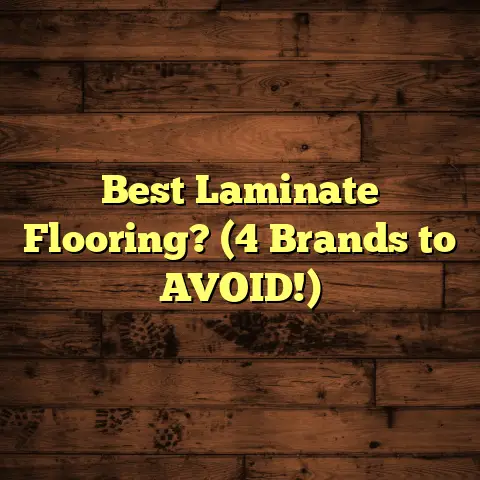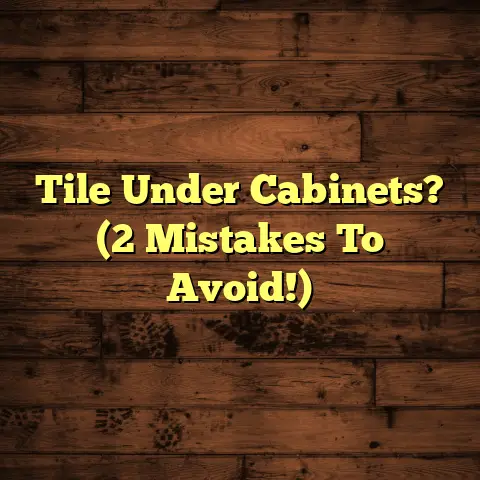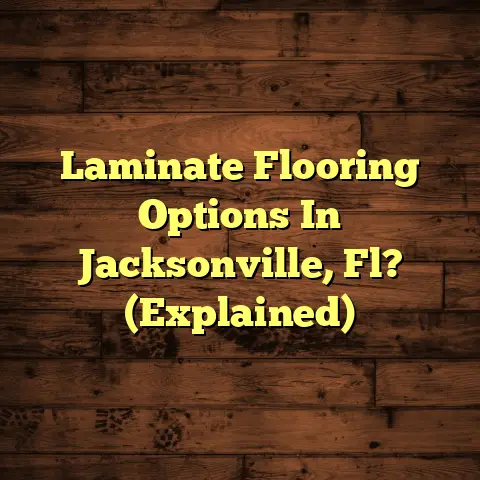Flood-Proof Flooring Options? (9 Water-Safe Picks!)
Imagine this: you’re chilling at home, maybe
watching your favorite show, when suddenly,
BAM! A flash flood hits.
It’s a homeowner’s worst nightmare, right?
And let’s be honest, the aftermath can be
devastating, especially when it comes to
your floors.
I’ve seen it firsthand – ruined
carpets, warped hardwood, the works.
But what if I told you there are flooring options
that can stand up to the challenge?
That’s what we’re diving into today.
We’re talking flood-proof, water-safe flooring
that can save you a ton of headaches
(and money!) down the road.
1. Understanding the Importance
of Flood-Proof Flooring
So, what exactly does “flood-proof flooring” even mean?
It’s not about flooring that’s completely
impervious to water (nothing truly is!).
It’s about choosing materials that can withstand
prolonged exposure to moisture without
buckling, warping, or growing mold.
Think of it as a shield against the elements,
giving you time to react and minimize damage.
Water damage is a sneaky beast.
It can lead to:
- Structural problems
- Mold growth (a health hazard!)
- Costly repairs
And certain flooring types are just asking for trouble. I’m talking about:
- Carpet: A sponge for water, breeding ground for mold.
- Solid Hardwood: Warps and swells like crazy.
Flood-proof flooring is an investment.
It’s not just about aesthetics; it’s about
protecting your home and your health.
It’s about peace of mind.
2. Key Features of Water-Safe Flooring
Alright, so what makes a flooring material “water-safe”? Here’s the checklist:
- Moisture Resistance: This is a no-brainer. The material should resist water absorption.
- Durability: It needs to withstand the force of floodwaters and potential impacts.
- Ease of Maintenance: You want something easy to clean and sanitize after a flood.
- Aesthetic Appeal: Let’s be real, you still want your home to look good!
These features aren’t just nice-to-haves; they’re
essential for longevity in flood-prone areas.
I’ve seen too many homeowners cut corners,
only to regret it later when their floors
are floating down the street.
3. Overview of Flood-Proof
Flooring Options
Okay, let’s get to the good stuff!
Here are nine water-safe flooring picks that I
recommend, along with a quick rundown:
- Luxury Vinyl Plank (LVP): Super durable, waterproof, and looks like real wood.
- Laminate Flooring: More affordable than LVP, but choose wisely for water resistance.
- Porcelain and Ceramic Tile: Classic, waterproof, and tons of design options.
- Concrete Flooring: Inherent water resistance, but needs proper sealing.
- Rubber Flooring: Great for basements, waterproof and shock-absorbent.
- Engineered Hardwood: A step up from solid wood, with better moisture resistance.
- Bamboo Flooring: Sustainable and surprisingly water-resistant.
- Cork Flooring: Naturally water-resistant and comfortable underfoot.
- Stone Flooring: Slate, granite – naturally waterproof and incredibly durable.
We’re going to dive deep into each of these, so you can make an informed decision for your home.
4. Luxury Vinyl Plank (LVP)
LVP is a game-changer. It’s made of multiple layers:
- Wear Layer: The top layer, protects against scratches.
- Print Layer: This is where the design magic happens.
- Core Layer: Usually made of PVC, this provides water resistance and stability.
- Backing Layer: Adds extra support and cushioning.
The key here is the waterproof core.
Unlike traditional vinyl, LVP is designed to
handle standing water without issue.
I’ve even seen some LVP products that can be
fully submerged without damage.
It’s also incredibly durable.
That wear layer can withstand a lot of abuse,
making it perfect for high-traffic areas.
And the design versatility is amazing!
You can find LVP that looks just like:
- Hardwood
- Tile
- Stone
Installation is usually a breeze, with click-lock
systems that make it a DIY-friendly option.
Just make sure your subfloor is level!
Maintenance Tips:
- Sweep or vacuum regularly.
- Mop with a damp cloth and mild detergent.
- Avoid harsh chemicals.
I’ve installed LVP in countless homes, and
I’m always impressed with its performance.
It’s a solid choice for flood-prone areas.
5. Laminate Flooring
Laminate is often confused with LVP, but
there are key differences.
Laminate is made of:
- Wear Layer: Similar to LVP, protects against scratches.
- Decorative Layer: A printed image of wood or tile.
- Core Layer: Usually made of high-density fiberboard (HDF).
- Backing Layer: Provides stability.
The HDF core is the weak point when it comes
to water resistance.
HDF is essentially
compressed wood fibers, which can swell and
warp when exposed to moisture.
However, some laminate flooring is treated
with water-resistant coatings or has a
waterproof core.
Look for labels that say
“waterproof laminate” or “water-resistant laminate.”
Don’t assume all laminate is created equal!
Laminate vs. Hardwood:
- Price: Laminate is generally more affordable.
- Water Resistance: Laminate (waterproof versions) is far superior.
- Durability: Hardwood can be refinished, laminate cannot.
- Aesthetics: Hardwood has a natural look and feel that’s hard to replicate.
Potential Limitations:
- Even waterproof laminate can be damaged by standing water for extended periods.
- Edges and seams are vulnerable to water penetration.
Choosing High-Quality Options:
- Look for a thicker wear layer.
- Choose a product with a waterproof core.
- Read reviews and ask for recommendations.
I’ve seen laminate hold up surprisingly well in some situations, but it’s crucial to do your research and choose wisely.
6. Porcelain and Ceramic Tile
Ah, tile – a classic for a reason.
Porcelain and ceramic tiles are made by firing
clay at high temperatures.
The result is a hard, durable, and waterproof surface.
Porcelain vs. Ceramic:
- Porcelain: Denser and less porous than ceramic, making it more water-resistant.
- Ceramic: More affordable than porcelain, but slightly less durable.
Both are excellent choices for kitchens, bathrooms,
and other areas prone to moisture.
They won’t warp, swell, or rot when exposed to water.
Plus, they’re easy to clean and sanitize.
Design Options:
- Endless colors, sizes, and patterns.
- Textured tiles for added grip.
- Realistic stone and wood-look tiles.
I’ve used tile in countless projects, and
I’m always impressed with its versatility.
It can be used to create everything from
modern minimalist spaces to rustic,
traditional designs.
Installation Considerations:
- Proper subfloor preparation is essential.
- Use a waterproof membrane under the tile.
- Grout needs to be sealed to prevent water penetration.
Tile is a fantastic option for flood-prone areas,
but it’s important to hire a qualified installer
to ensure it’s done right.
I’ve seen too many DIY tile jobs that end up
leaking and causing even more damage.
7. Concrete Flooring
Concrete – it’s not just for sidewalks anymore!
Concrete flooring has become increasingly popular
in recent years, thanks to its durability,
versatility, and inherent water-resistant qualities.
Concrete itself is a mixture of cement, water,
and aggregates (sand and gravel).
When properly sealed, it’s resistant to water penetration.
Finishing Techniques:
- Polishing: Creates a smooth, glossy surface.
- Staining: Adds color and depth.
- Epoxy Coating: Provides a durable, waterproof finish.
- Sealing: Protects against stains and moisture.
I’ve seen some stunning concrete floors that look
absolutely amazing.
They can be customized to match any style,
from industrial chic to modern farmhouse.
Potential for Cracks:
- Concrete can crack over time due to settling or temperature changes.
- Control joints can help minimize cracking.
Maintenance:
- Sweep or vacuum regularly.
- Mop with a damp cloth and mild detergent.
- Re-seal every few years.
Concrete is a great option for flood-prone areas,
but it’s important to address potential cracking
and ensure it’s properly sealed.
I always recommend hiring a professional
to install and finish concrete flooring,
as it requires specialized equipment and expertise.
8. Rubber Flooring
Rubber flooring is often overlooked, but it’s a fantastic option for basements, gyms, and other areas where water resistance and shock absorption are important.
Rubber flooring is typically made from recycled
tires or synthetic rubber.
It’s naturally waterproof and resistant to mold
and mildew.
Advantages:
- Waterproof
- Shock-absorbent
- Durable
- Easy to clean
- Slip-resistant
Ideal Applications:
- Basements
- Garages
- Gyms
- Playrooms
Design Options:
- Available in rolls, tiles, and mats.
- Wide range of colors and patterns.
I’ve installed rubber flooring in several basements,
and it’s always a hit with homeowners.
It’s comfortable underfoot, easy to maintain,
and provides a safe surface for kids to play on.
Installation Considerations:
- Subfloor needs to be level and clean.
- Use a waterproof adhesive.
Rubber flooring is a practical and affordable
solution for flood-prone areas.
It’s not the most glamorous option, but it
gets the job done.
9. Engineered Hardwood
Engineered hardwood is a great alternative to solid hardwood, especially in areas where moisture is a concern.
Engineered hardwood is made of multiple layers:
- Top Layer: A veneer of real hardwood.
- Core Layer: Made of plywood or HDF.
- Backing Layer: Provides stability.
The plywood or HDF core is more resistant to
moisture than solid hardwood.
It won’t warp or swell as much when exposed to water.
Engineered Hardwood vs. Solid Hardwood:
- Price: Engineered hardwood is generally more affordable.
- Water Resistance: Engineered hardwood is superior.
- Durability: Solid hardwood can be refinished multiple times, engineered hardwood cannot.
- Aesthetics: Both offer a natural wood look, but solid hardwood has a richer feel.
Maintenance Requirements:
- Sweep or vacuum regularly.
- Mop with a damp cloth and mild detergent.
- Avoid excessive moisture.
Aesthetic Appeal:
- Wide range of wood species and finishes.
- Can be installed in a variety of patterns.
Engineered hardwood is a good compromise between
the beauty of real wood and the practicality
of water-resistant flooring.
I’ve installed it in many homes, and it’s always
a popular choice.
10. Bamboo Flooring
Bamboo flooring is gaining popularity as a sustainable and surprisingly water-resistant option.
Bamboo is a grass that grows incredibly fast.
It’s a renewable resource that’s harvested without
killing the plant.
Water Resistance:
- Bamboo is naturally more water-resistant than traditional hardwood.
- However, it’s not waterproof.
Growth Characteristics:
- Grows quickly and regenerates easily.
- Requires less water and pesticides than traditional hardwood forests.
Bamboo vs. Hardwood:
- Sustainability: Bamboo is more sustainable.
- Water Resistance: Bamboo is generally better.
- Durability: Hardwood is typically more durable.
- Price: Bamboo can be comparable to hardwood.
Design Aesthetics:
- Unique grain patterns and colors.
- Can be stained to match any decor.
Installation Considerations:
- Subfloor needs to be level and dry.
- Use a moisture barrier.
Bamboo flooring is a great choice for eco-conscious
homeowners who want a water-resistant and
stylish flooring option.
I’ve installed it in several homes, and it’s
always a conversation starter.
11. Cork Flooring
Cork flooring is another eco-friendly option that’s naturally water-resistant and comfortable underfoot.
Cork is harvested from the bark of cork oak trees.
The bark regenerates, so the trees are not harmed.
Natural Water-Resistant Properties:
- Cork contains suberin, a waxy substance that repels water.
- It’s also resistant to mold and mildew.
Comfort and Warmth:
- Cork is naturally cushioning and provides insulation.
- It’s warm to the touch, making it a great choice for bedrooms and living rooms.
Maintenance Considerations:
- Sweep or vacuum regularly.
- Mop with a damp cloth and mild detergent.
- Re-seal every few years.
Potential for Damage:
- Cork can be damaged by sharp objects or heavy furniture.
- It’s not as durable as some other flooring options.
Cork flooring is a unique and sustainable option
that offers excellent water resistance and comfort.
I’ve installed it in several homes, and it’s
always a hit with homeowners who value
eco-friendliness and comfort.
12. Stone Flooring
Stone flooring is the ultimate in durability and
water resistance.
Slate, granite, and other types of stone are
naturally waterproof and incredibly long-lasting.
Types of Stone Flooring:
- Slate: A fine-grained metamorphic rock that’s known for its durability and unique texture.
- Granite: A coarse-grained igneous rock that’s incredibly hard and resistant to scratches and stains.
- Limestone: A sedimentary rock that’s softer than granite and slate, but still very durable.
Natural Beauty and Durability:
- Stone flooring adds a touch of elegance and sophistication to any home.
- It’s incredibly durable and can last for centuries.
Installation Challenges:
- Stone flooring is heavy and requires a strong subfloor.
- Installation can be labor-intensive and expensive.
Maintenance Tips:
- Sweep or vacuum regularly.
- Mop with a damp cloth and mild detergent.
- Seal regularly to protect against stains.
Stone flooring is a timeless and durable option
that’s perfect for flood-prone areas.
It’s an investment that will last for generations.
I’ve installed stone flooring in many homes, and
it’s always a showstopper.
13. Comparative Analysis of
Flooring Options
Alright, let’s break it down with a handy chart:
Price Points:
- Low: Laminate, Rubber
- Moderate: LVP, Porcelain/Ceramic Tile, Concrete, Engineered Hardwood, Bamboo, Cork
- High: Stone
Long-Term Value:
Consider the lifespan of the flooring,
maintenance costs, and potential for resale value.
While stone is expensive upfront, it can last
for centuries and add significant value to your home.
14. Case Studies: Successful
Flood-Proof Flooring Installations
Let me share a couple of stories from my own experience:
The Coastal Cottage: I helped a homeowner in a coastal town install LVP throughout their home.
They had experienced flooding in the past and were tired of replacing carpets.
The LVP has held up beautifully and provided peace of mind during recent storms.The Basement Remodel: I installed rubber flooring in a basement that had a history of water leaks.
The homeowner was thrilled with the comfort and water resistance of the rubber flooring.
It transformed the basement into a usable and enjoyable space.
These are just a couple of examples of how flood-proof flooring can make a real difference in people’s lives.
15. Conclusion: Making the Right Choice
Choosing the right flooring for a flood-prone area
is a big decision.
It’s important to consider your specific needs,
budget, and aesthetic preferences.
Remember these nine water-safe options:
- Luxury Vinyl Plank (LVP)
- Laminate Flooring
- Porcelain and Ceramic Tile
- Concrete Flooring
- Rubber Flooring
- Engineered Hardwood
- Bamboo Flooring
- Cork Flooring
- Stone Flooring
Each has its own unique benefits and drawbacks.
Do your research, ask questions, and choose the
option that’s right for you.
And don’t forget to hire a qualified installer
to ensure the job is done right.
Trust me, it’s worth the investment.
With the right flooring, you can protect your home from the devastating effects of flooding and enjoy peace of mind for years to come.





